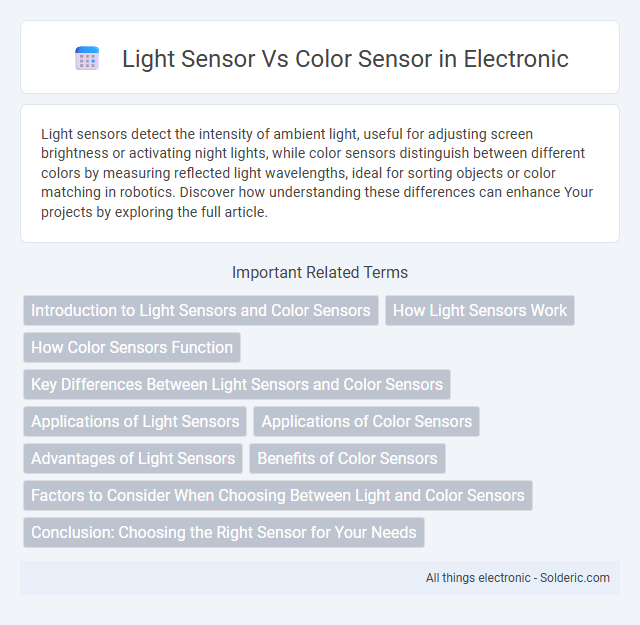Light sensors detect the intensity of ambient light, useful for adjusting screen brightness or activating night lights, while color sensors distinguish between different colors by measuring reflected light wavelengths, ideal for sorting objects or color matching in robotics. Discover how understanding these differences can enhance Your projects by exploring the full article.
Comparison Table
| Feature | Light Sensor | Color Sensor |
|---|---|---|
| Function | Measures light intensity | Detects and identifies colors |
| Output | Analog or digital light levels | RGB values or color codes |
| Sensors Used | Photodiode, phototransistor | RGB photodiodes, filters |
| Applications | Ambient light detection, brightness control | Color sorting, display calibration |
| Accuracy | Measures light intensity accurately | Identifies specific colors precisely |
| Complexity | Simple sensor design | More complex, requires color filtering |
| Cost | Generally low cost | Higher cost due to complexity |
| Examples | Photocells, LDRs | TSL2561, TCS3200 |
Introduction to Light Sensors and Color Sensors
Light sensors detect the intensity of ambient light by measuring brightness levels, enabling devices to adjust screen brightness and conserve energy. Color sensors analyze the wavelength of reflected light, allowing precise color detection and differentiation in applications like robotics and quality control. Both sensors utilize photodiodes but serve distinct purposes in managing light information for various electronic systems.
How Light Sensors Work
Light sensors detect ambient light levels using photodiodes or phototransistors that convert light into electrical signals, enabling devices to adjust brightness or perform light-based measurements. These sensors primarily measure intensity or luminance without differentiating color wavelengths. Understanding how light sensors work helps optimize your device's performance in varying lighting conditions by providing precise intensity data.
How Color Sensors Function
Color sensors function by detecting the wavelength of light reflected from objects using photodiodes equipped with color filters, typically measuring red, green, and blue components. These sensors convert the intensity of each color channel into electrical signals, allowing precise identification of object color and shade. Unlike simple light sensors that measure only light intensity, color sensors provide detailed spectral information for applications in robotics, quality control, and ambient light adaptation.
Key Differences Between Light Sensors and Color Sensors
Light sensors detect the intensity of ambient light, providing data primarily about brightness levels, while color sensors analyze specific wavelengths to identify colors and distinguish hues. Your choice depends on whether you need to measure general light conditions or accurately detect color variations for applications like display calibration or object sorting. Light sensors often use photodiodes or photoresistors, whereas color sensors typically employ RGB filters or spectrometers to capture detailed color information.
Applications of Light Sensors
Light sensors are widely used in applications such as automatic lighting control, where they detect ambient light levels to optimize energy consumption in homes and offices. These sensors also play a crucial role in mobile devices for adjusting screen brightness according to surrounding light conditions, enhancing battery life and user experience. Your smart home systems benefit from light sensors in security setups and environmental monitoring, ensuring efficient and responsive automation.
Applications of Color Sensors
Color sensors play a crucial role in applications requiring precise color detection and differentiation, such as quality control in manufacturing, sorting objects by color, and mood lighting control in smart homes. Unlike light sensors that measure intensity or brightness, color sensors analyze the wavelength composition to identify specific colors, making them ideal for detecting product defects, reading color codes, and enhancing robotic vision systems. Your projects benefit from their ability to provide accurate color information, enabling more sophisticated automation and user interaction.
Advantages of Light Sensors
Light sensors offer advantages such as high sensitivity to varying light intensities, enabling accurate detection of ambient lighting conditions for energy-efficient applications. They provide fast response times and low power consumption, making them ideal for real-time monitoring in automated lighting and display systems. Light sensors also perform effectively in dynamic environments where detecting changes in light levels is crucial for adaptive control.
Benefits of Color Sensors
Color sensors provide precise color detection and differentiation, enabling applications such as quality control, sorting, and color matching in industries like manufacturing and agriculture. They offer enhanced sensitivity to multiple wavelengths, allowing accurate identification of subtle hue variations that light sensors cannot detect. By delivering detailed color information, color sensors improve automation accuracy, product consistency, and reduce errors in color-sensitive processes.
Factors to Consider When Choosing Between Light and Color Sensors
When choosing between light and color sensors, consider the specific application requirements such as the need for detecting ambient light intensity versus identifying distinct colors. Light sensors are ideal for measuring luminance and adjusting brightness levels, while color sensors excel in applications requiring accurate color recognition and differentiation. Your decision should also factor in environmental conditions, sensor sensitivity, and integration compatibility with your system.
Conclusion: Choosing the Right Sensor for Your Needs
Light sensors excel at measuring ambient light intensity, making them ideal for applications like automatic brightness adjustment and basic light detection. Color sensors provide detailed information about object color and color temperature, suitable for tasks requiring precise color differentiation such as sorting or quality control in manufacturing. Selecting the right sensor depends on whether your project demands simple light measurement or accurate color recognition for optimal performance.
light sensor vs color sensor Infographic

 solderic.com
solderic.com